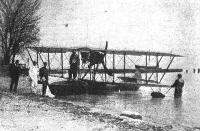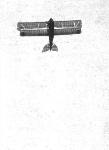
Описание
Страна: США
Год: 1916
Журнал Flight
Flight, September 7, 1916.
THE GENERAL AEROPLANE CO.'S FLYING BOAT.
Realising the increasing popularity of the flying boat among sportsmen in the States, more and more of the American manufacturers are turning their activities in that direction. Among others, the General Aeroplane Company, of Detroit, Mich., have recently produced a flying boat that is especially adapted for sporting purposes, and its general lines are shown in the accompanying scale drawing and illustrations. In the "Verville" flying boat, named after its designer, Alfred V. Verville, the Company has aimed at producing a craft embodying the best principles of construction with an efficient design rather than to attempt anything in the way of novelty.
The hull is built up of Honduras mahogany double-planked with aluminium bulkheads forming four watertight compartments, and has a concave vee bottom, with off-sheered deck and D-shaped tail. Aluminium handhole covers are provided, rendering access to various parts of the hull. The cockpit, which seats two side-by-side, is veneered with 1/8 in. Honduras mahogany and upholstered with green leather, filled with "Kapok." The polished mahogany dash-board is equipped with altitude barometer recording to 15,000 ft.; "Tycos" inclinometer; "Tycos" speed indicator; "Tel" revolution indicator; petrol tank pressure gauge, oil pressure gauge, electric light switch, dash-board light, motor cut-out switch, hand throttle and magneto spark control. Four special Tungsten ceils for lighting purposes are provided, and the hand-pump is located in a convenient position for the pilot at the side of cock-pit. The two streamline wing-floats are of mahogany, and have a displacement capacity respectively of 200 lbs.
The main planes are divided into sections, three for the top and two for the lower. The top planes are attached to a centre plane-section - which, it will be observed, is peculiar in that it is arched - supported above the boat by two pairs of struts, whilst the lower plane sections are mounted on the hull.
A highly efficient wing section (Eiffel) suited to the requirements of this type of machine is employed, and the planes are built up in the orthodox way on two main spars with ash compression ribs, and spruce webs and battens. Shelby oval steel tubing is used for the trailing edge, and the whole wing structure is braced with strong Roebling aviator wire. The framework is covered with Irish unbleached linen (having strength in weft of 91 lbs. per linear inch, and in warp of 103 lbs.) doped with nine coats of Emaillite, and surfaced with three coats of spar varnish. The interplane struts are of Virginia silver spruce, well seasoned and shellaced, and bound with grey silk ribbon to relieve shattering. The strut sockets are clamped around wing spars, thus avoiding the necessity of the securing bolts piercing the spars.
Hinged to extremity of top plane rear spar by five cold rolled steel hinges are the ailerons, which are interconnected. Lynite pulleys, having brass bushings throughout, are used for the control gear.
The tail planes consist of a semi-circular stabilizing plane, mounted above the stern of the boat, to which the two elevator flaps are hinged, and a triangular vertical fin, to which the partly-balanced rudder is hinged. Either Deperdussin, Curtiss, or the makers' "three-in-one" systems of control may be fitted.
The engine, a 100 h.p. Curtiss OXX, is mounted above the hull under the top plane centre-section, and drives direct a three-bladed "Paragon" propeller, 8 ft. 3 ins. diam. by 5 ft. 6 ins. pitch, constructed of oak tipped with copper. A flat copper-tube cellular type radiator, in nickel-plated brass casing, and weighing 41 lbs., is mounted in front of the engine. The water capacity is 2 1/2 galls. Starting the engine is accomplished from the cock-pit by means of a crankhandle.
A factor of safety of seven is used throughout the machine. All wiring is doubled (factor of safety taken on one cable), and French "National" turnbuckles are used exclusively; all cable is wrapped with copper wire, sweated with solder and at least three ins. long: control cables are extra flexible 19-strand cotton centre Roebling grade wire. Metal parts are either nickel or treated with non-corroding metal enamel.
The main characteristics are as follows :-
Span: top 38 ft., bottom 30 ft.; gap, 6 ft.; cord, 5 ft.; gliding angle, 1 in 7; length over all, 27 ft. 9 ins.; speed range, fully loaded, 42-70 miles per hour; weight (loaded), 2,050 lbs.; weight (unloaded), 1,450 lbs.
- Журнал Flight
Фотографии
-
Журнал - Flight за 1916 г.
A general view of the General Aeroplane Co's flying boat.
-
Журнал - Flight за 1916 г.
The General Aeroplane Co.'s flying boat taxying on the water.
-
Журнал - Flight за 1916 г.
View from below of the General Aeroplane Co.'s flying boat in flight.
-
Журнал - Flight за 1916 г.
THE GENERAL AEROPLANE CO.'S FLYING BOAT. - Plan, front and side elevation to scale.




